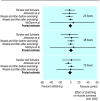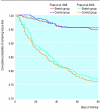Effects of stretching before and after exercising on muscle soreness and risk of injury: systematic review
- PMID: 12202327
- PMCID: PMC119442
- DOI: 10.1136/bmj.325.7362.468
Effects of stretching before and after exercising on muscle soreness and risk of injury: systematic review
Abstract
Objective: To determine the effects of stretching before and after exercising on muscle soreness after exercise, risk of injury, and athletic performance.
Method: Systematic review.
Data sources: Randomised or quasi-randomised studies identified by searching Medline, Embase, CINAHL, SPORTDiscus, and PEDro, and by recursive checking of bibliographies.
Main outcome measures: Muscle soreness, incidence of injury, athletic performance.
Results: Five studies, all of moderate quality, reported sufficient data on the effects of stretching on muscle soreness to be included in the analysis. Outcomes seemed homogeneous. Stretching produced small and statistically non-significant reductions in muscle soreness. The pooled estimate of reduction in muscle soreness 24 hours after exercising was only 0.9 mm on a 100 mm scale (95% confidence interval -2.6 mm to 4.4 mm). Data from two studies on army recruits in military training show that muscle stretching before exercising does not produce useful reductions in injury risk (pooled hazard ratio 0.95, 0.78 to 1.16).
Conclusions: Stretching before or after exercising does not confer protection from muscle soreness. Stretching before exercising does not seem to confer a practically useful reduction in the risk of injury, but the generality of this finding needs testing. Insufficient research has been done with which to determine the effects of stretching on sporting performance.
Figures
Comment in
-
Reducing risk of injury due to exercise.BMJ. 2002 Aug 31;325(7362):451-2. doi: 10.1136/bmj.325.7362.451. BMJ. 2002. PMID: 12202310 Free PMC article. No abstract available.
-
Stretching before or after exercising has no effect on muscle soreness or risk of injury.Aust J Physiother. 2003;49(1):73. doi: 10.1016/s0004-9514(14)60197-5. Aust J Physiother. 2003. PMID: 12793442 No abstract available.
-
Stretching before and after exercise: effect on muscle soreness and injury risk.J Athl Train. 2005 Jul-Sep;40(3):218-20. J Athl Train. 2005. PMID: 16284645 Free PMC article.
References
-
- DeVries HA. Prevention of muscular distress after exercise. Res Q. 1961;32:177–185.
-
- DeVries HA. Electromyographic observations of the effects of static stretching upon muscular distress. Res Q. 1961;32:468–479.
-
- Gleim GW, McHugh MP. Flexibility and its effects on sports injury and performance. Sports Med. 1997;24:289–299. - PubMed
-
- Hartig DE, Henderson JM. Increasing hamstring flexibility decreases lower extremity overuse injuries in military basic trainees. Am J Sport Med. 1999;27:173–176. - PubMed


